by Margaret Sgarra
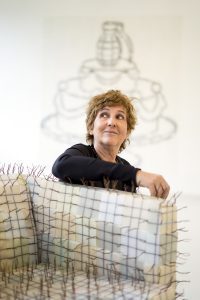 Through complex and emblematic works of art with an installation nature, the artist Silvia Levenson investigates the complexity of today’s society, reflecting on the critical issues and problems of the present, with a particular reference to the condition of women within both family and society. Her works, made of glass, are as crude as immediate, highlighting gender discrimination, the importance of solidarity and the fight against violence without half measures.
Through complex and emblematic works of art with an installation nature, the artist Silvia Levenson investigates the complexity of today’s society, reflecting on the critical issues and problems of the present, with a particular reference to the condition of women within both family and society. Her works, made of glass, are as crude as immediate, highlighting gender discrimination, the importance of solidarity and the fight against violence without half measures.
When did you realize that you wanted to be an artist?
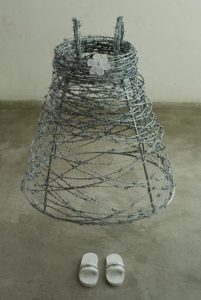
Always. As a child with my sister Bibi we invented stories, we drew and we did everything to escape from the life that adults proposed to us. I don’t have a formal artistic education. I studied graphics in Argentina. In 1980 with my family we came to Italy to escape from the military dictatorship. I was 23 years and I had two children: 4-year-old Natalia and 11-month-old Emiliano.
At the center of your work, there are objects of common use, which are associated with much more complex issues, such as love, identity and the human condition. How do you choose the pieces of your works and how do your projects come up?
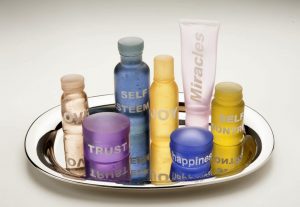
I am influenced by what I read, the films I watch and the knowledge that we all have a daily life and we relate to objects that we are familiar with. In my first works, I used the glass knife as the symbol for the ambiguity it represents. On one hand it’s a very useful object that we use in the kitchen, but it can turn into a deadly weapon as well. In this way I didn’t focus only on violence, but on the mechanisms of this violence and on the daily tensions.
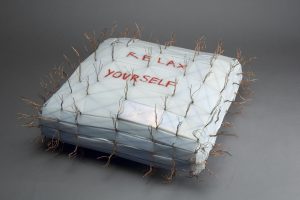
A shower of knives on the city or on an armchair alludes to a danger that we do not see, but that is there above our heads. The glass knife was the first common object I have used in my works.
In your research there are also some recurring and contrasting elements, such as: bombs and cakes, clothes and barbed wire. How does these associations generate?

Through my works I investigate the contradictions of our patriarchal society which offers us the ideal of romantic love, based on the control of the body and of the psyche of women and girls. Because of this my wedding cakes are decorated with unexploded pink bombs. While baby clothes of barbed wire remind us of the limitations and the sense of ownership that is often associated with their bodies.
In a society characterized by an image saturation, the written word seems to lose its importance. Your works mix strong phrases and images. What is the importance you give to the word and the image?
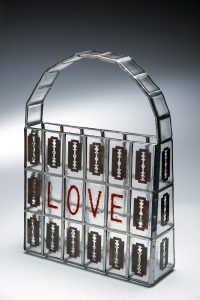
Words are important to me: they can heal or cause wars. In my sculptures I create a kind of short circuit between images and words. Like recreating the packaging of cosmetics and children’s toys on which it is provocatively written “miracles”, or “we don’t talk about this”. Through my work I try to bring out what is often considered “unspeakable”, that is hidden in the folds of everyday life.
“Il Luogo più pericoloso” is a performative and photographic project created together with Natalia Saurin. This work reflects on how acts of gender-based violence, particularly those against women, are sometimes imbued with senseless justifications, which derive from a culture that is too deeply-rooted and distorted. It is an installation consisting of common kitchen dishes, decorated with phrases often said by the guilty or disclosed by the media to minimize the extent of these episodes. Can you tell us how this project was born and what does it represent for you?

We have been wanting to work with my daughter Natalia Saurin for a long time, she is an artist too. The artwork “Il luogo più pericoloso” consists of everyday kitchen dishes, made of ceramic, decorated with phrases extrapolated from the media to minimize episodes of the news section related to violence or used by the violent to motivate his gesture. These objects testify a war too often consumed at home. So, the installation “Il luogo più pericoloso” tells of a war taking place in our homes.

The chosen phrases speak of desire, control and about the relationship of power. They are words said by men unable to handle a rejection or the failure of a love relationship (“mine or nobody’s”; “I hit you but I love you”; “it was a raptus”; are just a few examples). Phrases that distort the reality of violence against women. In fact, the femicide is not the consequence of a sudden and momentary violent impulse, but the result of a continuum of violence that last in time. It is not jealousy that kills, but rather the violent act of an oppressor who wants to control his partner. The installation was presented for the first time in 2019 in Florence, at the Museo of 900, on the occasion of the International Day for the elimination of violence against women.

On the 25th November 2020 the dishes at the center of these performance should have been exhibited in the courtyard of the Palazzo Reale in Milan for The Talents of Women, but due to the pandemic the exhibition has become an action in Piazza Duomo. Here, together with other women, we were portrayed with the dishes by the photographer Marco Del Comune. Then, in 2021 there was a further evolution of the work. A video was made, documenting the action of breaking the plates with the words used by the media written on them, words which trivialize and minimize violence against women. This audiovisual work was projected in various Italian cities: Milan, Turin, Verona, Biella, Genoa, Rome, Salerno, Savona, Finale Ligure, Potenza, Buenos Aires in Argentina and Maryland in the United States.
Do you think there is a feminist art capable of provoking thematic reflections and gender discrimination in those who observe it?

I believe that feminist art, or at least the art aware of gender discrimination, can certainly induce, as you say, to reflect or to change the audience’s gaze.
As an artist and as a woman what do you wish to inspire through your artistic practice? And do you think that the language of art can help making tomorrow’s world better?
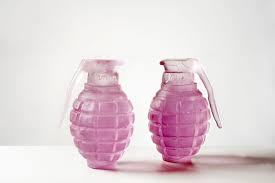
Chandra Livia Candiani in one of her poems wrote “reality hurts me”. And it hurts me too, and the only way I have found to live in this world is living through art. I explore and observe what happens around me to transform it into sculptures and installations. I don’t know if art will change the world, but it certainly will better ourselves, it touches us and sometimes makes us reflect.
What are your next projects and what are you working on at the moment?
This year I was invited to teach in various workshops in Italy and abroad. Teaching, sharing experiences is part of my artistic practice. So I’m going to the United States, Costa Rica, Honduras, Germany, Spain and Portugal to attend conferences and give courses. I will have a little time, but I am working for my next year solo show, which will be a reflection on climate change.